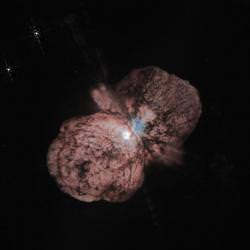Kaboom kaboom. That’s what an international team of astronomers saw when they tracked the death of one of the most massive stars that can exist.
Japanese supernova hunter, Koichi Itagaki, first discovered an exploding star in the galaxy UGC4904 back in 2004. It flared briefly and then faded away over the course of 10 days. Two years later, he discovered another supernova in exactly the same location.
Subsequent observations with larger telescopes confirmed that the supernova, named SN2006jc, did indeed happen at exactly the same location as the previous detonation. The 2004 event must have just been a large outburst, similar to what was seen on Eta-Carinae back in the 1850s.
The researchers think this kind of event could actually be more common than previously believed. A new survey called Pan-STARRS may check up on previous supernova events to see if there’s any new activity.
Original Source: Queen’s University Belfast News Release

